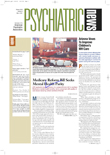Many psychiatric residential treatment centers that treat youth whose care is paid for by Medicaid will be caught in a Catch-22 situation if the federal government’s interim final rule on seclusion and restraint goes into effect later this month.
The Bush administration extended the rule’s effective date of March 23 by 60 days to give senior appointees to the Health Care Financing Administration (HCFA), which oversees Medicaid, time to review the rule and provide input. It’s possible the rule could be further delayed or withdrawn.
APA’s position is that the rule should be withdrawn because “it will have a costly and profound impact on the ability of psychiatric residential treatment centers (RTCs) to admit children and youth, especially those at high risk for aggressive behaviors that may require temporary restraints,” said APA Medical Director Steven Mirin, M.D., in a March letter to HCFA Acting Administrator Michael McMullan.
If RTCs are forced to close because the costs of compliance are too great, the most vulnerable individuals would be left without access to residential treatment, wrote Mirin.
In a letter sent in February, APA called on McMullan and Health and Human Services Secretary Tommy Thompson to withdraw the rule and meet with all concerned parties. APA also complained in the letter that the rule adds one more layer to a confusing patchwork of laws, rules, and standards on seclusion and restraint (
see box on page 50).
HCFA has the authority under the Children’s Health Act of 2000 (Psychiatric News, November 17, 2000) to issue rules on seclusion and restraint that are stronger than the law’s provisions, according to HCFA’s Web site.
“Based on the mounting evidence of harm to children and adolescents resulting from the use of restraint and seclusion, we believe regulations that impose more prescriptive standards governing the use of restraint and seclusion in psychiatric residential treatment facilities are warranted.”
HCFA refers to the 1999 General Accounting Office report that found that children have higher rates of restraint and seclusion being used on them than do adults and are at greater risk of serious injury or death than adults as a result of improper restraint and seclusion practices.
While APA agrees that safety is paramount, it contends that HCFA wrote the final interim rule without considering the type of patients treated in RTCs and the limited supply of physicians and nurses in certain parts of the country.
Cost Implications
Psychiatrists who direct small community-based RTCs fear that the staffing requirement in the interim final rule might put them out of business.
Psychiatrists on site will be required to issue written orders to initiate seclusion or restraint. If they are off site, they must issue verbal orders to registered nurses on site, according to the regulation.
Steven Jewell, M.D., deputy executive director of Pressley Ridge Schools in Pittsburgh, which provides mainly residential treatment and educational services in the community, told
Psychiatric News, “HCFA wrote the rule based on the inpatient hospital model, which has registered nurses on site 24/7 and physicians on call 24/7.”
Jewell helped write the letter that the Pennsylvania Psychiatric Society sent to HCFA in March commenting on the rule.
He estimated that only one-third of RTCs in Pennsylvania have registered nurses working around the clock. “Mental health counselors with bachelor’s degrees make up the frontline staff,” said Jewell.
That means that about two-thirds of RTCs will have to hire registered nurses to cover all shifts. “Given the nursing shortage and the demand for competitive salaries, this is an expensive proposition,” said Jewell.
RTCs are totally dependent on Medicaid funding, at least in Pennsylvania. If they don’t comply with the interim final rule, they will be forced to close their doors or find another source of funding, according to Jewell.
Training and Monitoring
The Pennsylvania Psychiatric Society commented to HCFA that “properly trained clinical staff can fulfill the responsibilities needed to maintain resident safety during a restraint without the need for registered nurses or verbal orders from physicians.”
The society didn’t address seclusion because the state has prohibited its use in RTCs, noted Jewell.
For the last 15 years Pressley Ridge Schools has sent its clinical supervisors for annual training in the safe use of restraints and alternatives to restraints. The supervisors in turn train their staffs in these techniques.
Because the goal is for staff to use restraint as a last resort, most of the four-day course is devoted to teaching de-escalation and conflict-management techniques, said Jewell.
“Regular staff training has helped to significantly reduce the use of restraint in our facility and is an important tool for counselors interacting daily with patients,” said Jewell.
Training, however, is not enough. The RTC must continually monitor the process surrounding the use of restraint to detect problems and recommend improvements, according to Jewell.
At Pressley, the staff person who restrains a child fills out a report of the incident within 24 hours, which is given to his or her supervisor. They meet to review the process, and the supervisor makes suggestions for improvements, if needed, he said.
The supervisor forwards the report to an internal risk-management committee, which checks, for example, to see whether the staff tried less-restrictive alternatives first and whether anyone was hurt, said Jewell.
When committee members see something questionable, they can interview the staff person and child involved. “We require the risk-management committee members to randomly interview at least five kids and staff every quarter about any episodes of restraint they participated in and write a report on their findings,” explained Jewell.
The quarterly reports are sent to the executive committee of Pressley Ridge Schools. “We have invested in the oversight process, which holds the staff accountable,” he commented.
Jewell believes that restraint should be an option for children with a history of aggressive behaviors until the treatment plan takes effect.
He points out that children with more severe problems are being sent to RTCs in Pennsylvania because state hospitals have closed their child and adolescent inpatient units, and managed care companies are limiting hospital stays.
“Many of these kids show up with self-mutilation, suicidal, and assaultive behaviors,” observed Jewell.
Other Provisions
The interim final rule on seclusion and restraint also includes these requirements for RTCs:
• Seclusion and restraint may be used only to ensure the safety of the resident or others and not for purposes of coercion, discipline, convenience, or retaliation.
• Any order to initiate seclusion and restraint must specify the least-restrictive intervention able to resolve the situation effectively.
• Seclusion and restraint may not be initiated simultaneously.
• Age-specific time limits must be followed when using seclusion and restraint (a maximum of four hours for residents aged 18 to 21, two hours for residents aged 9 to 17, and one hour for residents aged 8 and under).
• A physician or registered nurse must evaluate the patient face to face within one hour of initiation.
• A debriefing with the staff involved and the resident must be held within 24 hours. Staff also must discuss the incident with their supervisor.
• Trained clinical staff must be present during the use of restraint and seclusion.
• Staff must be trained in the safe use of restraint and seclusion and CPR and demonstrate their competencies twice a year.
The National Alliance for the Mentally Ill (NAMI) strongly supports the rule. According to a NAMI press release, “A major NAMI public-policy objective has been advocating for a HCFA single national standard on restraint use, particularly one that covers residential treatment centers for children.”
Several health care groups besides APA signed the February letter to Thompson calling for the withdrawal of the interim final rule. These are the American Academy of Child and Adolescent Psychiatry, American Hospital Association, American Medical Association, National Association of Psychiatric Health Systems, and National Association of Psychiatric Treatment Centers for Children.
APA’s March letter to McMullan is available at www.psych.org/pub_pol_adv/rtcinterimfinalruleltr32701.cfm. The text of the regulation can be accessed on the Federal Register’s Web site at www.access.gpo.gov/su_docs/fedreg/frcont01.html by clicking on the January 22 issue. ▪

